
The Cerema, Institut Carnot Institute Clim'adapt, works and mobilizes those concerned to develop new remedial solutions to reduce the vulnerability of buildings exposed to the RGA and its resilience to climate change.
Impacts and exposure to RGA in France: key figures
In France, the latest established by the Ministry in charge of ecology [1] at the end of June 2021 of more than 10.4 million individual houses potentially very exposed to the phenomenon of clay soil shrinkage and swelling (RGA), half of which were built after 1976. Moreover, the new national zoning shows that the strong or average exposure to RGA now concerns 48% of metropolitan areas. Thus, three quarters of communes have more than 50% of the houses exposed according to the latest figures from the MissionRisquesNaturels[2].
On the basis of the figures published in 2021 by the Caisse Centrale de Réassurance[3], the estimated average cost of insured damage for drought represents at least 50% of the overall average cost compared to other natural natural disasters, for each year since 2018 and reaches nearly 77% in 2020.
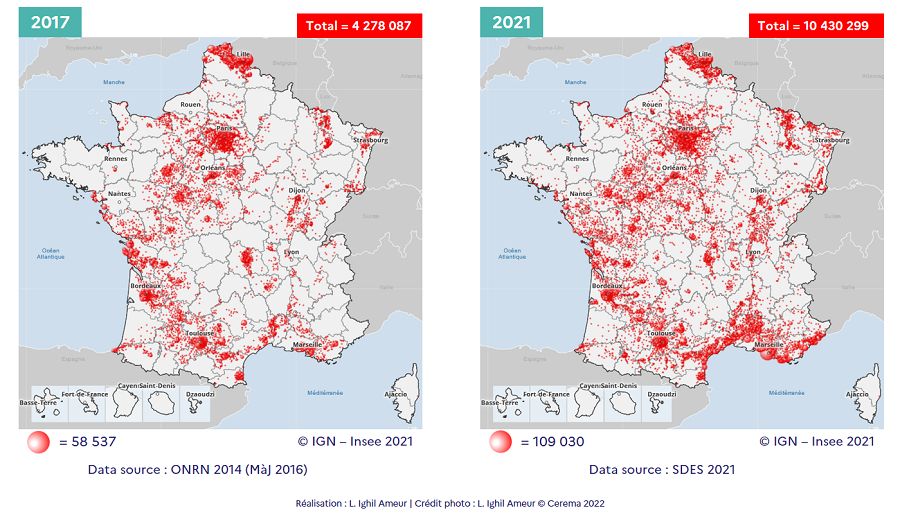

Roads are also severely impacted by the drought through damage most often characterized by longitudinal cracks near the edges and very significant deformations constituting a danger for the safety of users. The impact of climate change on roads will be increasingly significant in terms of costs related to maintenance of the exposed network.
On March 10, 2022, the Court of Auditors published its report on "The maintenance of national and departmental roads" [4] citing the work of Cerema in partnership with the departments of the Centre-Val de Loire region in favour of the resilience of infrastructures to the test of climate change climate change [5].
Shrinkage and swelling process in clay soils
The natural processes of shrinkage and swelling are a succession of variations of water content of a clay soil under the effect of hydric and cyclic solicitions influenced by the meteorological conditions of meteorological conditions of drought and precipitations. In addition, the phenomenon of RGA depends on the mineralogical nature of the clayey ground and the close environment in which it occurs.
To understand how the shrinkage and swelling processes of a clay soil are, Figure 1 shows the evolution of the state of an idealized soil element subjected to a complete of drying-wetting cycle.

In Figure 1, a saturated soil element subjected in a first time to a drying path (drought) records both a volume deformation (red arrows) in the direction of shrinkage and a loss of mass loss of mass linked to the evaporation of water present in the soil. This first phase, called "shrinkage", is characterized by the approach of the solid grains and continues until the shrinkage limit noted wSL, from which the drying continues via evaporation.
On this drying path, the water content of the soil decreases and conversely, the suction increases and the soil becomes unsaturated in the final state. Note that the kinetics of shrinkage and drying depend, among other things, on the hydric conditions of the environment. Indeed, Ighil Ameur and Hattab (2019) observed faster shrinkage rates at high suction imposed to an initially saturated kaolinite sample. The suction of the soil, which can be influenced by the weathering conditions and those of the conditions, is likely to affect the shrinkage kinetics under the effect of the drought.
In figure 1, on a path of humidification by water infiltration (precipitation), the soil undergoes the phenomenon of swelling in two phases (Reiffsteck, 1999):
-
the primary phase, with the migration or diffusion of water into the soil from its from its extremities. It is more or less depending on the nature of the soil, its state of saturation according to the mode of imbibition and the state of the constraints. It can last from a few hours to more than a month.
-
the secondary phase, linked to the progressive hydration of the clay minerals and corresponds to a process of slow kinetics. On this way of humidification, the water content of the soil increases and inversely, the suction decreases and tends to zero when the soil becomes saturated in the final state at the end of the complete drying-wetting cycle.
Evolution of the RGA phenomenon under the effect of climate change
The question of the impact of climate change on drought losses and the phenomenon of phenomenon was anticipated a few years ago through prospective studies and modelling from different angles (climatic insurance and phenomenological). Plat et al (2009) have studied this subject in the framework of the Natural Hazards, Insurance and Climate Change Working Group by raising the following questions:
-
Will the RGA phenomenon intensify? Will it affect buildings that were previously spared? Will it lead to more on the affected houses?
-
Will there be a change in the geographical extension affected by the RGA?
-
What will be the impact of the increase in the frequency of droughts on the disorders caused?

The phenomenon of RGA intensifies naturally and durably with the accentuation of the drying-wetting cycles which, by occurring in an even more random way, the hydromechanical properties of the clay soils.
In addition, longer and more intense droughts will generate a deeper desiccation, estimated today to the first two meters close to the surface of the surface exposed to evapotranspiration. This will require heavier and more costly support in terms of in terms of reinforcement work. Depending on the construction quality of the exposed structures and the configuration of their close environment, this can indeed affect constructions buildings that were spared in the past and induce consequent disorders.

The increase in the frequency of extreme droughts observed in the last six years will result in an increase in the vulnerability of buildings and a cumulative effect of disorders. Thus, these cumulative disorders will require heavy and expensive works.
For drought damages compensated by insurers, the new projection of the French Insurance Federation the average annual cost (13.8 MD€ between 1989 and 2019) to 43 MD€ and estimates the share of the effect of climate change at 17.2 MD by 2050 [6].
Sociological and psychological impacts of the RGA on the victims (case of individual housing)
If the RGA phenomenon has been studied and documented in France for several years, there is still a lack of knowledge among victims and local stakeholders on the impact of drought and RGA on the building process and the constructive measures to protect themselves from it. The victims feel often helpless when faced with the cost of the work and the psychological impact that the deterioration of their homes causes. Moreover, without support, the victims are not aware of the compensation procedures in the event of recognition of natural disaster from the state (cat-nat) and the exceptional aid to which they could be eligible in the absence of cat-nat recognition.
Let's take the example of the commune of Cour-Cheverny in the Loir-et-Cher which has still not been recognized as a cat-nat drought and this since 2015. Paradoxically, the municipality has more than 96% of houses strongly or moderately exposed to the RGA. With gaping cracks, open of a few centimeters and which worsen from drought to drought, the mayor and his constituents are in the incomprehension as for the non-recognition of their commune as a cat-nat site [7].
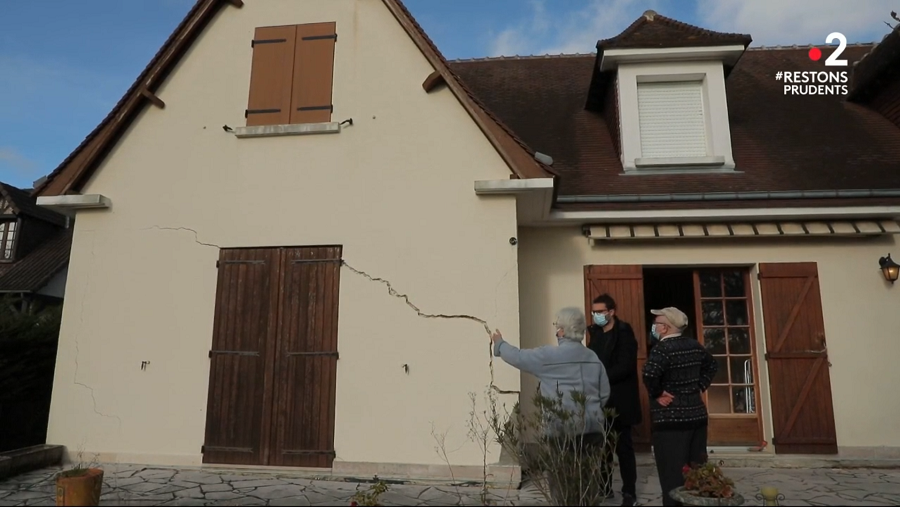
The victims, sometimes gathered in collectives or calling on associations, express their concerns about each of the situations they are now experiencing on a daily basis with sometimes critical situations, like losing their job as a childcare provider due to the large and visible cracks in their workplace (their house) or going to work fearing that that the cracked structure of the of the car garage will collapse on the employees. It It is therefore important to consider the sociological and psychological impacts, attributable to the consequences of the drought and the RGA phenomenon on the global response and management of this phenomenon by public authorities and socio-economic stakeholders concerned.
Solutions for adapting to climate change climate change
1. Prevention actions, information and awareness:
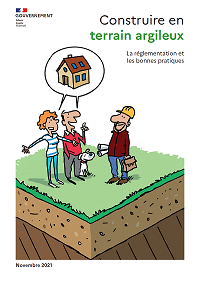
"Building in clay soil, the
regulations and good practices
practices"
Construction professionals are not always sufficiently informed and trained on the on the phenomenon of RGA, its proper characterization and good construction practices for the prevention of drought damage. Thus, for any new house construction, the Direction de l'Habitat de l'Urbanisme et des Paysages (DHUP) published in November 2021 a communication to the public on the new regulation (art. 68 of the ELAN law and its three application application) and the good practices to build in clayey ground sensitive to the RGA phenomenon [8]. It should be noted that the good practices mentioned in this booklet, in order to lower the impact of the immediate environment, are also to be considered for existing buildings exposed to RGA.
For an efficient management and dissemination of information and advice on drought and the RGA phenomenon, the services in charge of natural risks in the communities and the State services should coordinate their work at a local level, in order to better inform and guide the inhabitants who are requesting information. In addition, it is recommended to raise awareness among the owners of vulnerable houses (built in zones of high or medium RGA exposure) to take the necessary measures to limit the impact of risk factors in the environment close to the house to reduce its vulnerability to RGA.
2. MACH solution - MAison Confortée par Humidification:
In the perspective of developing new remediation solutions, alternatives to conventional repair techniques, Cerema has experimented on the scale of a damaged test house, between the end of 2016 and the end of 2020, an innovative solution called MACH [9].
The principle of the MACH solution is to maintain a balanced water state at the level of the soil during periods of drought. It consists in rehydrating the foundation soil during the drought by the rainwater, previously collected and stored stored during the wet period.
It is a resilient solution and an adaptation to climate change allowing to stabilize existing damage (small scale) and to prevent the occurrence of new cracks.
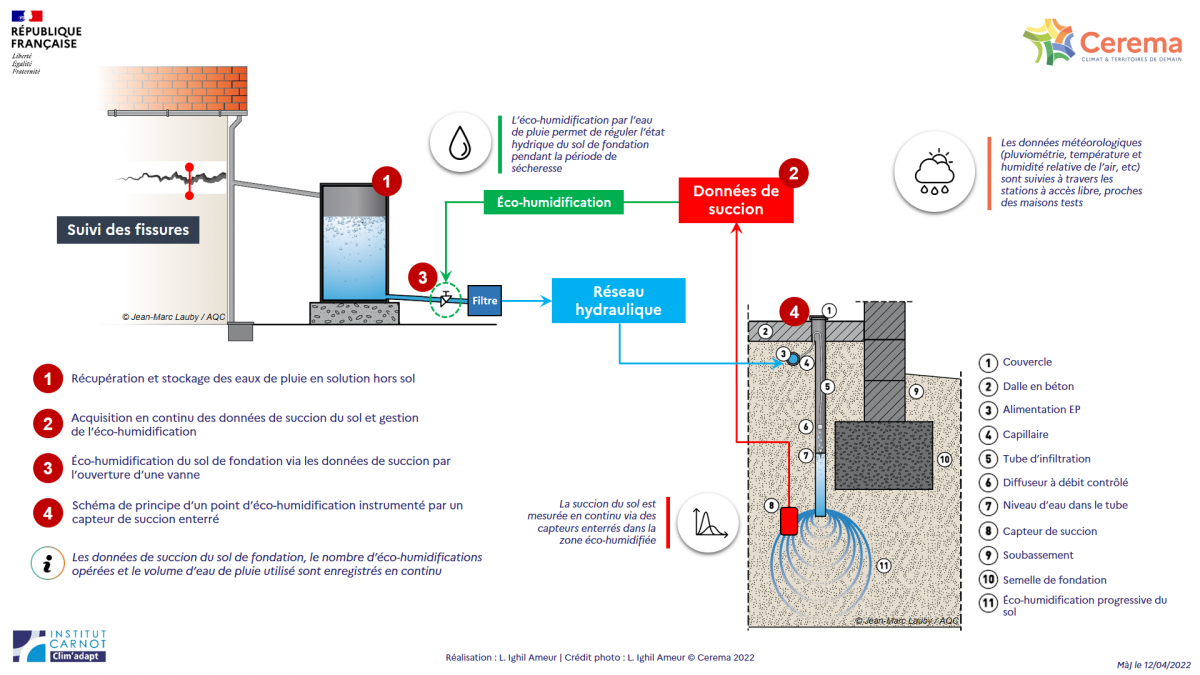
The results observed during the 4 years of intense droughts from 2017 to 2020 are satisfactory both in terms of stabilization of the opening of the existing cracks and the absence of new cracks appearing on the facades [10]. This solution is effective, inexpensive, and therefore accessible to all disaster victims.
As an indication, the experimental process MACH was set up for a total cost of 15 k€ HT, that is to say a cost clearly lower than that of a traditional underpinning. This technology, currently tested in post-disaster stabilization, could also be used in the prevention phase to avoid the occurrence of damage to exposed buildings [11].
3. ORSS - A unique observatory for the resilience of road infrastructures:
Conventional pavement repair techniques are not adapted to the RGA phenomenon, the consequences for managers are significant in terms of annual maintenance costs. On the other hand, there is a strong stake safety of users. Cerema, in partnership with with the departments of the Centre-Val de Loire region, is developing new remediation solutions remediation solutions to limit the vulnerability of roads of roads affected by the RGA phenomenon in the context of climate change.
This unprecedented multi-partnership is called ORSS, Observatory of Roads Affected by Drought [12]. As for now, ORSS is a regional partnership co-financed by Cerema and five departments (Cher, Indre, Indre-et-Loire, Loir-et-Cher and Loiret), 8 experimental sites sites and 16 test beds, 11 remediation solutions tested and a total of 2.5 km of roads reinforced. The contractualization is done independently between Cerema and each of the departments for a period of 5 years.
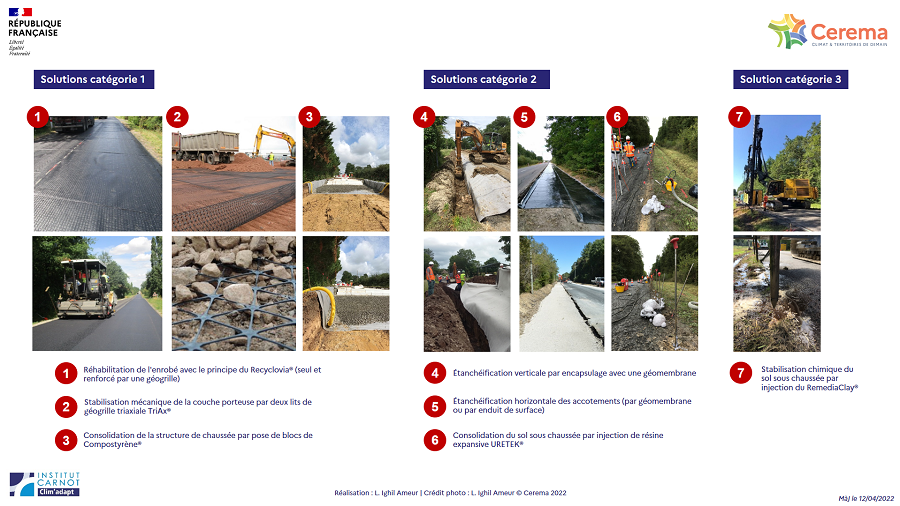
Depending on the reinforced part of the elements the road, the remedial solutions can be classified be classified into three categories:
-
Category 1: it consists of acting on the pavement structure in order to reinforce it to take up the rise of cracks [13] ;
-
Category 2: it consists of acting on the environment close to the road to limit the effects of factors that amplify desiccation, such as evapotranspiration from the roadside and the road shoulders and the root influence of nearby vegetation in the vicinity [14];
-
Category 3: it consists in acting directly on the clay soil via a deep treatment that can reach up to 4.00 m deep to reduce by physico-chemical relations its sensitivity to RGA and to maintain a balanced water status [15].
In addition, instrumentation with suction sensors accompany the implementation of these solutions to analyse and evaluate their effectiveness and durability.
[1] SDES (2021) New zoning of exposure to clay shrinkage and swelling: more than 10.4 million individual houses potentially very exposed. exposed. Web article of the ministry in charge of ecology in France.
[2] MNR (2022) Reference systems for the resilience of buildings to natural hazards. Web book of the Mission Risques Naturels.
[3] CCR (2021) News cat nat events : Return on events 2019-2020. Web article from the Caisse Centrale de Reassurance.
[4] Court of Accounts (2022) Maintenance of of national and departmental roads. Report public thématique.
[5] Cerema (2022) The Resilience of infrastructures" sheets: RGA. Sheet n°01 dedicated to the phenomenon and its impact on road infrastructures.
[6] France Assureurs (2021) Impact of climate change on the insurance industry 2050. Study report.
[7] France Télévisions (2020) A devastated by drought is still not recognized as a recognized as a natural disaster. Article web de France Info.
[8] DHUP (2021) Soils clay, drought and construction. Web article of the French ministry in charge of ecology.
[9] Cerema (2019) Stabilization of the phenomenon of shrink-swell of clay soils under houses: an innovative system by rainwater infiltration of rainwater.
[10] Ighil Ameur (2021) Experimental analysis of shrinkage-swelling phenomenon of clays -application to an individual house affected by drought under climate change effects. ASCE EMI-PMC International Conference (virtual event), New York, USA.
[11] MRN (2021) The MACH solution: MAison Confortée par Humidification (MAH) from Cerema. 9th episode of the " minutes of the " minutes of cat-nat and climatic innovation " of the MRN and France Assureurs.
[12] Cerema (2020) Adapting roads to the impacts of climate change: The Observatory of Roads Affected by Drought.
[13] Cerema (2021) Road exposed to soil shrinkage and swelling: Evaluation of a of a reinforcement technique using Compostyrene® blocks.
[14] Cerema (2021) Injection of of expanding resin to reinforce roads exposed to to droughts, tested by Cerema and the department of Indre-et-Loire.
[15] Cerema (2021) The Cerema and the Loiret department are launching an experiment with the RemediaClay® process RemediaClay® process to stabilize roads exposed to drought.
En savoir plus :
Cour des comptes (2022) Sols argileux et catastrophes naturelles : des dommages en forte progression, un régime de prévention et d'indemnisation inadapté. Communication au Comité d’évaluation et de contrôle des politiques publiques de l’Assemblée nationale:

